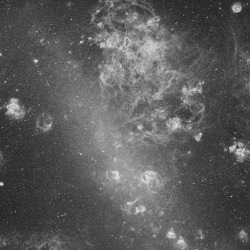
The Large Magellanic Cloud by John Gleason
In August 1519, a Portuguese admiral with five tall ships and a crew of 270 men departed from Spain on the first attempt to circle the earth by taking a route predominantly through the southern hemisphere. The admiral, named Ferdinand Magellan, didn’t return to Spain having died on the voyage during a battle in the Philippines and only one ship returned with eighteen tattered men three years later. The voyage was a milestone in human history by discovering the full scope of the Earth’s size, the need for an international date line and the two Clouds of Magellan, the largest one pictured here.
The Magellanic Clouds were actually known previously by the indigenous people living in the southern hemisphere. A Persian astronomer made the first written reference almost 600 years prior to Magellan?s discovery, but it was Magellan who made their existence part of western knowledge and thus they were named after him. The clouds are actually two out of thirteen dwarf satellite galaxies that orbit the Milky Way. The total number circling our island universe will probably grow since two new ones have recently been reported and additional ones are already suspected.
The Large Magellanic Cloud is the more massive and closer of the two named after the explorer and the second closest galaxy to our own. Located about 180,000 light years distant in southern constellation of Dorado, the Large Magellanic Cloud is estimated to span over 15,000 light years and contains about 60 globular clusters, 400 planetary nebulae, 700 open clusters, and several hundred thousand giant and supergiant stars. It is speculated that this satellite galaxy may have formerly been a larger spiral that ventured too close and was partially devoured by the Milky Way.
This spectacular portrait of the Large Magellanic Cloud is a mosaic of six separate images taken through a hydrogen-alpha narrow band filter. The filter rejects white light that is visible to the naked eye and only allows the very dark red radiation emitted by hydrogen gas, a primary component of nebulae, to pass onto the CCD.detector. The area of this image covers is several times the diameter of the full moon. The Large Magellanic Cloud is the glowing elongated object extending from the eleven o’clock position towards the center. Around it are dozens of nebulae, the most prominent of which is called the Tarantula, located to the upper right of the galaxy in this picture. This is also the vicinity where the closest supernova in 300 years was discovered in 1987- SN1987A.
Veteran astrophotographer John Gleason produced this picture earlier this year from the Sky Shed Observatory in Coonabarabran, New South Wales, Australia. John used a four-inch Takahashi FSQ astrograph and an 11 mega-pixel astronomical camera to record the twenty cumulative hours of exposures required to produce this striking deep space image.
Do you have photos you’d like to share? Post them to the Universe Today astrophotography forum or email them, and we might feature one in Universe Today.
Written by R. Jay GaBany
